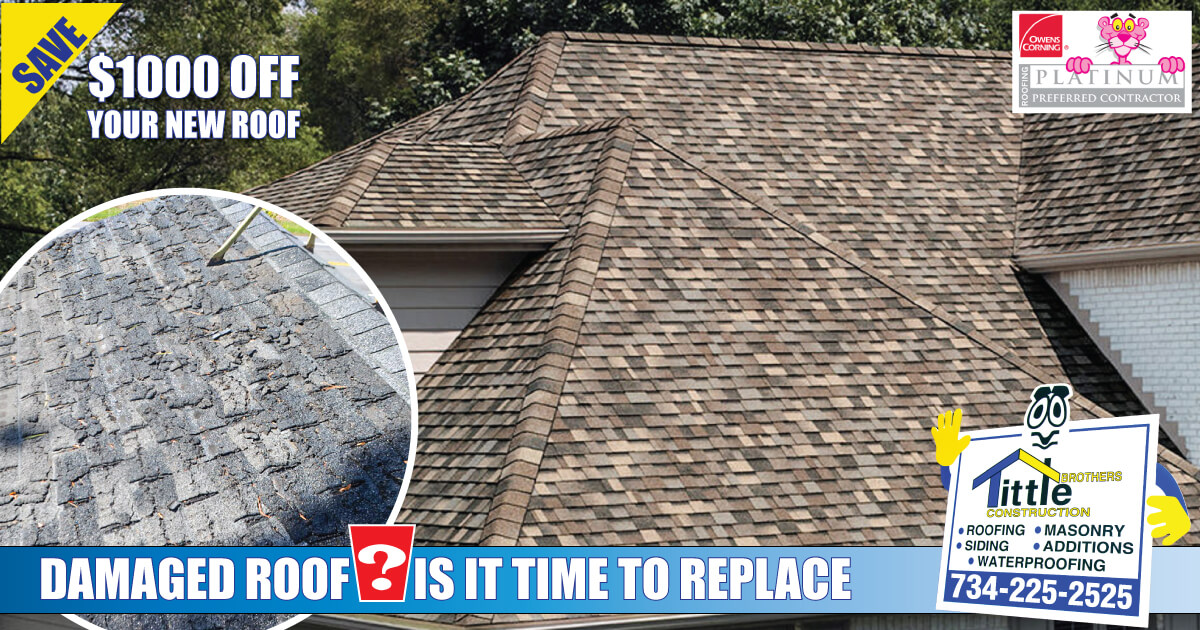Properly taking care of a home takes a lot of work and a surprising amount of scheduling. Homes need constant care, but in a way that’s easy to work into our routine. We may tidy, do laundry, and mow the lawn on a regular basis but it takes awareness of your home over months and years to schedule all of the correct maintenance tasks. And if there is one thing that almost everyone forgets to tend at some point, it’s your roof. It is particularly difficult to keep up with your roofing Michigan Homeowners where yearly storms can put some serious wear on your shingles, it’s all too easy to let your roofing maintenance go so long that your home starts to experience problems.
If you’ve started to wonder if there is undetected damage to your roof causing problems, no doubt you’ve begun to research signs of roofing trouble. You may have noticed that most roof guides start outside, as if you are already up a ladder and standing on your own roof while reading the article. Here at Tittle Brothers, we know that most residents notice roofing troubles not out on their own roofs but indoors or perhaps standing on the ground looking up.
To help you determine if your home really does need roofing work, we’ve put together a comprehensive guide to roof trouble signs from a resident’s point of view. Starting indoors and assuming you will only go up a ladder if you absolutely have to. Ready? Let’s go!
Indoor Signs of Roofing Problems
Many people get the first inklings that they have roofing trouble while spending normal time inside their home. Here are the signs of a damaged roof that can be detected indoors.
– Damp Walls or Ceilings
The biggest problem with a damaged roof is that it lets moisture in. Humidity is bad enough but when it rains, water comes in through cracks or gaps in your shingles. From there, it runs down the support beams and into the walls and ceiling of a home. If you are seeing signs of water running or pooling behind your home’s interior walls or ceiling, your roof is the most likely culprit, followed by internal plumbing leaks.
– Peeling Wallpaper and Paint
If not enough moisture has seeped in to cause visible damp spots yet, there may be enough moisture or built-up humidity coming in through your roof to do lesser damage. Look for signs of wallpaper and interior paint peeling away from the wall. This means that the drywall behind is moist with unwanted water seepage from the roof.
– Drop in AC Efficiency
And, of course, having open spaces in your roof will wreak havoc on your HVAC efficiency. Whether you’re running the heater during cold months or your AC in the warm months, a damaged roof becomes almost immediately apparent upon looking at your monthly power bill. If the number is unexpectedly high, you probably have an air and temperature leaking problem through the top of your Michigan home.
Attic Signs of Roof Trouble
Many people discover their roof troubles by taking a visit to the attic. This is when you can be closest to your roof without actually going outdoors. Remember that in the attic, you are literally looking at the support beams and underside of the roof itself. Any signs of damage in your attic could also mean trouble above for your roof.
– Light Shining Through
The easiest-to-spot sign that you need to call your roofing contractors in MI is seeing sunlight shining through the top of your attic. While you may have a little window or two beneath the surface of the roof or set into a dormer, no part of the roof surface should allow sunlight to be seen. If you can see beams of light or even just little glimmers, this means that the seal of your roof has been compromised and anything from rain to small animals can get in.
– Sagging Support Beams
Your roof is a vital part of the home’s structure and, incidentally, propped on top of everything else. If your roof gives way, it could fall into the rest of your home. This is exactly what you should be thinking if you see support beams in the attic sagging or soft with rot. When a roof starts to leak, water runs down the support beams and saturates them with water, which can cause critical structural damage that may require full roof re-installation.
– Growing Mold Colonies
Moisture allowed in by gaps and flaws in the roof also makes your attic the perfect place for mold spores to settle and grow. Mold spores are always in the air and they like to grow in dark, moist places full of natural materials like wood. If you see dark, discolored, and potentially fuzzy patches growing in your attic, beware. This means roof damage and probably water damage as well.
– Unusual Dampness or Damp Spots
Even if the mold doesn’t come, any dampness in your attic should be cause for suspicion. If you see puddles, damp support beams, or damp spots on anything in the attic, your roof may be letting in the rain and humidity. Remember that the damp spots may not show up directly below the roof damage, as water often runs down to a lower point in the roof before dripping or running down a vertical structure.
– Animal Inhabitation
Another downside of a damaged roof is that small creatures may be able to squeeze between the cracks to reach the safe and protected space inside your attic. If there are signs of birds nesting or local rodents living inside your attic, chances are that they got in through a roof in need of serious repairs.
Signs of Roof Trouble From the Ground
Once you have investigated inside your house and from the safety of your attic, it’s time to take a look at your roof from the outside. Many guides don’t mention this, but there are a number of ways to detect a need for roofing repairs from the ground. Take a walk into your yard and get a good view of your roof surface from a distance. If it helps, use binoculars or a high-quality camera zoom function to see details.
– Discolored Patches
If your roof looks like there are two or more colors of tile in splotches or sections, this can indicate a number of roofing problems. Old shingles that have started to lose granules will look darker or lighter than those around them and areas with shingles damaged by a storm may look different from undamaged shingles as well. Moss and algae growth can also cause a discoloration in patches on your roof, as can extensive moisture damage from snow or leaves sitting in damp piles for too long up there.
– ‘Rough-Looking’ or Clearly Damaged Shingles
Another clear sign that you need new is simply recognizing damage when you see it. If a section of your shingles is clearly broken or looks rougher than the rest of the roof from a distance, this indicates exactly what it looks like: You have damaged shingles that will need to be replaced, at least in that section.
– Sagging and Buckling
The outside silhouette of your home can show you something very important: whether or not your roof is leaning inward. Ridges should be perfectly parallel with the ground, and if they sag or buckle this is a sign that your roof has very serious structural issues. Sagging along the sides is also a very bad sign. If your roof is sagging or buckling, you’ll need to call your local Southeast MI roofing contractors immediately. That’s when to call the best, Tittle Brothers Construction, an Owens Corning Platinum Preferred Roofing Company.
Ladder-Top Signs of Roof Damage
As professional roofers, we know that going up onto a roof can be dangerous and even climbing a ladder needs a buddy to hold the ladder for you. This is why so few homeowners go up onto their roofs and generally we encourage people to stay safely on the ground. However, if you want a closer look, the safest way to do this is by checking it out from the top of your ladder. Here’s what you can spot once up-close and personal with your roof:
– Curling and Broken Shingles
Shingles that are aging or have taken storm damage will usually be damaged in distinct ways. The most common types of shingle damage are curling, peeling, or broken shingles. Curling happens when the corners of a shingle curl away from the roof surface, making a gap underneath. Peeling is when shingles pull one edge up away from the surface of the roof, usually pushed by wind. And, of course, broken shingles usually happen as a result of impacts and big storms.
– Pock-Marked Shingles
Another form of obvious damage is when your shingles seem to have little craters or pock-marks in them. This only happens as the result of hail, usually hail large and heavy enough to make a real impact. The problems with hail damage is that it lightly pulverizes your roof and can knock weather-resistant granules off the surface. If you see these, most of the affected shingles will need to be replaced.
– Granules In the Gutter
The granules on your composite asphalt roofing shingles are there to help the shingles resist the UV rays of the sun. Without them, your roof will start to decay at a rapid rate. However, shingles are also only rated for 15-25 years and after a certain time, the granules start to wash away. When this happens, you will find a number of roof-colored granules in your rain gutter. For Michigan Homes, this is a clear sign that your roof is on its last legs.
– Missing Patches of Shingles
If you can see missing patches of shingles or areas that are clearly lower than other parts of your roof then there are some serious problems at play. Missing shingles and low sections of your roof are places where debris and water can gather to cause further damage. It is also a likely indication that unwanted water and other things are already getting into your home.
– Obvious Impact Damage
Rounding out the ladder-top checks, sometimes it is just obvious when something has hit your roof with a tremendous impact. Large tree branches and other similar hazards can blow onto your roof during storms and cause a notable section of damaged shingles in a clear impact crater. If you can tell by looking that your roof has been damaged, it’s important not to let any time pass before starting repairs.
Circumstantial Signs of Roofing Concerns
Finally, sometimes you can know that your roof needs attention even if there are no inward or outward signs of damage. Roofs have a natural lifespan and when that time is reached, reinstallation will become increasingly necessary. Here’s how to use circumstance to determine if you need to call your local roofers – Tittle Brothers Construction, an Owens Corning Gold Award recipient year after year.
– Your Roof is Older than 15 Years
An interesting fact about roofs is that most people don’t actually know how old their roof is. When you buy a home, the previous owner almost never clues you in on when they last updated the roof and, in fact, they may not have maintained it at all. However, if you happen to know (or can easily guess) that the roof is older than 15 years since the last reinstallation, it’s time to have it installed again. Old roofs have old shingles that shed granules and are at a greater risk for damage and decay. If you don’t need a new roof after 15 years, you certainly will after 20.
– Several Nearby Neighbors Hire Roofers
And as our last point, don’t forget to keep an eye on your neighborhood. The homes of many neighborhoods were all built at the same time, meaning that their roofs are also the same age. If several of your neighbors seem to be getting roof work in the same year, chances are that your home will need the same. Use this as a clever clue if you’re not sure how old your roof is and call for inspection, repair, and possibly reinstallation on cue with the rest of the neighborhood.
As a homeowner, it’s important to know what’s going on with your roof and detect signs of damage as soon as possible. Hopefully, this checklist has given you some insight on spotting roof trouble and when to call for the Best Michigan roofing company, tittle Brothers Construction in the nick of time. For more information about how to take great care of your precious Michigan home, contact us immediately!



